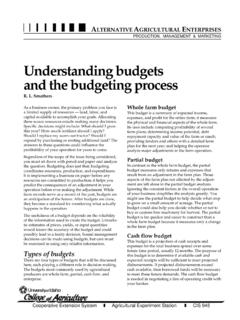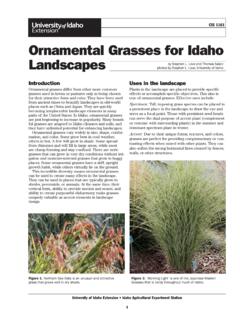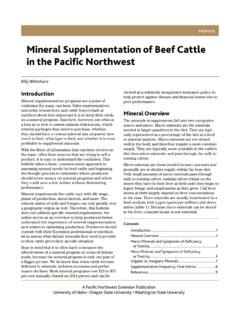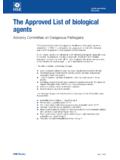Transcription of Judging Beef Cattle and Oral Reasons 101
1 1judging beef Cattle and oral Reasons 101 Judging beef Cattle and oral Reasons 101 CINDY A. KINDER, Extension Educator, University of Idaho Extension, Gooding CountyDENISE MAVENCAMP, 4-H and FFA VolunteerPNW 669 A Pacific Northwest Extension Publication University of Idaho Oregon State University Washington State UniversityJUDGING & oral REASONSO verviewthis booklet will help youth and beginningproducers to understand the five basic criteria forselecting a beef animal. it will also help beginnersin 4-H and ffa livestock Judging to understandproper note-taking format and the structure to oral should be used by youth and adults together, at club meetings, in classrooms, at field days, orat workshops as a livestock Judging reference. as judgers gain more experience, they can buildtheir note-taking and oral - Reasons skills byattending regional Judging camps or clinics. CONTENTSP arts of a beef associated with a beef a beef animal ..5 Judging beef your notes to prepare oral and transitions in oral Reasons skills4-H livestock Judging programs help youthdevelop life skills that make them better leadersand citizens and build stronger communities.
2 Leadership Teamwork Self-motivation Marketable skills Critical thinking Problem solving Decision making Communication Self-esteem Character Self-responsibilityPhotos by cindy a. KinderPublished and distributed in furtherance of the acts ofcongress of May 8 and june 30, 1914, by university ofidaho extension, the oregon state university extensionservice, Washington state university extension, and department of agriculture three participating extension services offereducational programs, activities, and materials withoutregard to race, color, national origin, religion, sex, sexualorientation, age, disability, or status as a disabled veteranor Vietnam-era veteran, as required by state and federallaws. university of idaho extension, oregon stateuniversity extension service, and Washington stateuniversity extension are equal opportunity february 2015 2015 by the university of idahoParts of a beef animalKnowing the parts of an animal will help you understand what someone is saying about an animal.
3 It will alsohelp you give correct information about your animal to someone, a veterinarian, for example. study the partsof the beef animal below. once you know them, study the next animal that associates specific terms withthose parts. 3judging beef Cattle and oral Reasons of or associated with a beef animalKnowing the parts of an animal is important, and so is knowing the terms that are associated with those can build confidence and portray competence when you talk the same terminology as other producers. 4judging beef Cattle and oral Reasons or to pins; level hipped of height; region of body bodied; deeper of rib; rib fronted; thin necked of chest floor; wider trackingABDFCGHIJEKS electing a beef animalselecting the right beef animals for your operation isimportant. Whether you have a small or large operationor just one animal, having the wrong animal can costyou money. besides the industry goals listed in the box,there are five main criteria to consider when selectingbeef Cattle : (1) growth and frame or skeletal size, (2) muscling, (3) volume, performance, (4) condition,trimness, and (5) structure, soundness, balance.
4 Growth and frame or skeletal sizethe beef industry has ideal final live weights of1250 1400 pounds and carcass weights of700 900 pounds. Market-ready animals that are toosmall (less than 1000 lb) cost the industry more perpound to process. those that are too large (1500 lb)are too big for processing facilities, and their cuts ofmeat are too large for consumers. indicators of size arelength of body, height at the hip, and length and sizeof the cannon QuestionsIdentify the steers with large, medium, or smallframes as measured by hip height. (Find hip heighton the illustration showing terms associated with a beef animal, page 4.) MusclingMuscling is important to the meat animals produce more meat and less fat. consumers are very conscious of fat and prefer beef with less fat. You can see indicationsof muscling in the round, in the width of stance, and over an animal s back. Discussion QuestionsLook at the side and rear views of these two steer is light muscled and which is mediummuscled?
5 (Answer: Black steer is light muscled.)5judging beef Cattle and oral Reasons 101 MARKET beef INDUSTRY GOALSAge at market: 14 18 monthsLive weight: 1250 1400 poundsHot carcass weight: 700 900 poundsKidney, pelvic, and heart fat (KPH): or lessFat thickness: inch or lessRibeye: square inches Quality grade: choice or higherYield grade: or lessVolume, performancethe volume, or capacity, of an animal indicates how well the animal may perform. You want adeep-bodied animal that can consume largeamounts of feed to allow it to grow and reach market weight or maturity faster. indicators ofcapacity and performance are ribcage length, depth, and shape (spring); depth of the flank; and width of the chest QuestionsCompare the volume of the two Shorthorn animals(top). Then compare the widths of the chest floorsof the Hereford and Angus animals (bottom). Condition, trimness the amount of trimness and condition (fat) an animal has also relates to its on the type of animal you have (market or breeding) you want an animal that is nottoo fat or too thin.
6 You can see indications of fat inthe brisket, over the ribs, in the flank, on the pin bones, and in the cod/udder QuestionsLook at the two steers; can you see differencesin condition? (Blue steer is heavier conditioned.)Structure, soundness, balance strong bone and correct skeletal structure isessential for any animal traveling to feed and water. You can observe structure in the angle of the shoulder, the levelness of top line and hip, the pastern angle, and in the animal's is the overall attractiveness of the should be evenly balanced from the front to the rear. Discussion QuestionsFind the correct front leg and rear leg structures in this illustration. 6judging beef Cattle and oral Reasons 101 Source: Ohio State University Extension, outreach arm of the Collegeof Food, Agricultural, and Environmental beef cattleNote taking Presenting oral Reasons is the most valuable experience you will have in livestock Judging . it helps you to thinkand state your thoughts clearly. it also demonstrates your knowledge and vocabulary.
7 Being able to defend adecision builds your confidence and self-esteem. no matter what career you choose, communicatingeffectively is a must to be successful. success in Judging starts with note taking. during contests, you will judge several different classes in a short time and give your oral Reasons later. You willneed to take notes on what you see about the animals in each class. You will then study the notes beforegiving oral Reasons to a judge. a good set of notes should help you remember the class in your mind. You will take notes only on classes that have been assigned as Reasons classes. once you have evaluated andplaced the animals in the class, then take notes. a 5- by 8-inch steno notebook is suggested for use in taking beef Cattle and oral Reasons 101introduction:# and idgrant (good)criticize (bad)compare (good)# and idgrant (good)criticize (bad)compare (good)# and idgrant (good)criticize (bad)compare (good)# and idgrant (good)criticize (bad)compare (good)Note-taking formatThe format for notes is broken down into rows: tHe first roW and heading is the introduction tothe class.
8 It tells what you judged (angus heifers, forexample) and how you placed the class (4-1-3-2, forexample). the introduction also explains how easyor hard it was to place the class of animals. tHe second roW explains why the 1st placeanimal is over the 2nd place animal. tHe tHird roW explains why the 2nd place animalis over the 3rd place animal. tHe fourtH roW explains why the 3rd placeanimal is over the 4th place animal. tHe final roW explains why the last animal is lastand is the conclusion of the row after the first has four columns: nuMber and identification animals arenumbered 1 through 4, and an identification pointis used to describe individual animals in the class. grant give an overall big picture of an animal bystating a good quality of the animal in that there may be no grant for an animal. criticize list 1 or 2 bad qualities of the animal inthat row. sometimes there may be no criticism. coMPare list two or three good qualities of theanimal in that row, stating why it placed over thenext animal.
9 This is what a blank note page should look like. Leave enough space in each box for your Name:Class Placing:8judging beef Cattle and oral Reasons t start taking notes until you have placed theclass and marked your your notes in the format below in order to helpyou give a fluid, organized set of Reasons . to be general in the terms that you use todescribe the animal in each box, but write as much aspossible to describe the animal. You will have time touse terms when you prepare to deliver your your notes readable and brief; this will preventyou from memorizing your notes. You should be ableto remember the animals, not your notes. t forget to write down an id point and sex,if needed, for each sure to use the correct sex of the animal in classesthat are of mixed sex and use your id points whendescribing the the time during non- Reasons classes to lookback at your notes and prepare your Reasons orcomplete your FOR EFFECTIVE NOTE TAKING AND REASONSThis is how you would fill in your note how easy or hard it was to place the class.
10 State overall comment aboutoutstanding individual animal or top pair of # andlist one why 1st placeanimal wins any bad qualitiesof the 1st place animal(optional) .say why 1st placeanimal beats 2nd placeanimal by saying thegood qualities of 1stplace # andlist one one overall goodquality of the 2ndplace any bad qualitiesof the 2nd place animal. say why 2nd placeanimal beats 3rd placeanimal by saying thegood qualities of 2ndplace # andlist one one overall goodquality of the 3rdplace any bad qualitiesof the 3rd place animal. say why 3rd placeanimal beats 4th placeanimal by saying thegood qualities of 3rdplace # andlist one one overall goodquality of the 4thplace any bad qualitiesof the 4th place animal. thank youClass Name:Class Placing:Using your notes to prepare oral reasonsHere is an example set of notes. They are color-coded to show you the transfer of information from yournotes to your oral these notes, here is an example set of Reasons :9judging beef Cattle and oral Reasons 101 Easily started, highest quality4 Show halterHighest qualityNo obvious criticismNicely balanced Soundestmoving/structureMore feminineLonger strided1 Red tagMost like classwinner from rib andmuscle standpointCoarse and straightshoulderedRoaches in top when onthe move Wider chestedBolder ribbedShape to top and hip Deeper rib/flank3 Yellow tagLonger frontedLeveler hippedMore attractiveStrong toppedShallowest bodiedNarrowest chestedAlso straight shouldered Higher qualityLonger, thinner necked, flatter shouldered, more parallel in herlinesHeavier muscled2 No tagDeepest bodied andeasiest fleshingLowest quality, poorestbalanced, flattest ribbed Thank youClass Name:Senior Yearling Angus HeifersClass Placing.









